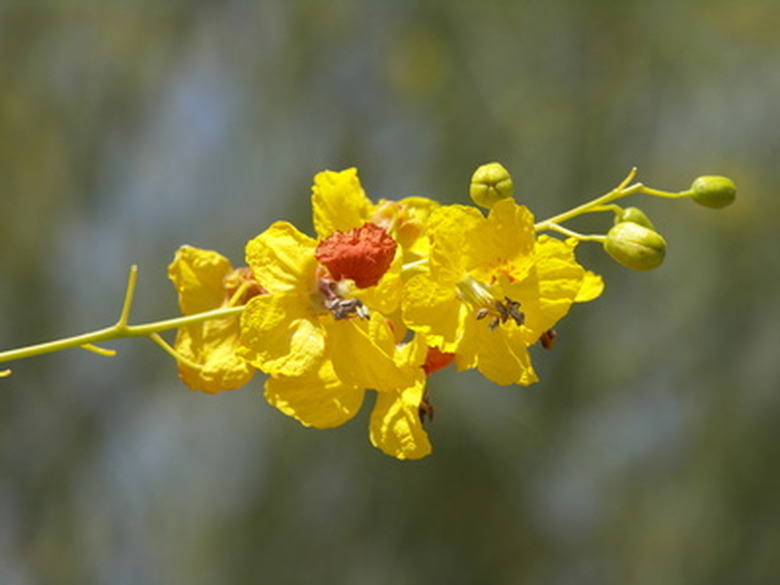Southern Arizona Shade Trees
Both low and high elevation deserts cover southern Arizona, including the prominent Phoenix and Tucson cities. Low annual rainfall and long growing seasons with hot, intense sunlight beckons gardeners to grow some trees to produce refreshing shade. To conserve irrigation water, choose drought and heat-tolerant tree species. Deciduous trees block summer sun but allow the warm winter sun to reach the ground or house windows. This region is in Sunset climate zones 12 and 13.
Parkinsonia
Once listed in the botanical genus Cercidium, Parkinsonia comprises three trees of note to cast shade on southern Arizona's dry landscapes. The blue palo verde (Parkinsonia florida) grows quickly to about 30 feet tall and wide and is seasonally partially deciduous and provides attractive yellow flowers in spring. Hybrid palo verde grows slightly smaller, 25 feet tall and wide while foothills palo verde (Parkinsonia microphylla) grows much slower to only 15 feet tall and wide, more like a shrub but useful in small-scale yards or around house foundations.
- Both low and high elevation deserts cover southern Arizona, including the prominent Phoenix and Tucson cities.
- Hybrid palo verde grows slightly smaller, 25 feet tall and wide while foothills palo verde (Parkinsonia microphylla) grows much slower to only 15 feet tall and wide, more like a shrub but useful in small-scale yards or around house foundations.
Desert Willow
Attract hummingbirds when the desert willow (Chilopsis linearis) bears its violet pink flowers from spring to fall when its leaves cast welcome shade. This winter deciduous tree grows quickly to 25 feet tall and 20 feet wide.
Silk Floss Tree
With fat thorns on its trunk and limbs, silk floss tree (Chorisia speciosa) slowly grows to 30 feet tall and 25 feet wide, casting shade until dry soils cause leaves to drop each year. Flowering is magnificent, with so many pink flowers that they case decent shade themselves each autumn.
Indian Rosewood
A fast growing and large shade tree, Indian rosewood (Dalbergia sissoo) reaches 40 feet tall by 30 feet wide.
Coolibah
Evergreen and casting dappled shape year round, the coolibah (Eucalyptus microtheca) reaches an irregular but upright habit of 35 feet tall by 25 feet wide. It grows nicely in irrigated turn areas, too, even though it has low water needs.
- Attract hummingbirds when the desert willow (Chilopsis linearis) bears its violet pink flowers from spring to fall when its leaves cast welcome shade.
- With fat thorns on its trunk and limbs, silk floss tree (Chorisia speciosa) slowly grows to 30 feet tall and 25 feet wide, casting shade until dry soils cause leaves to drop each year.
Afghan Pine
Only use the fast-growing Afghan pine (Pinus eldarica) if you have the space as it reaches a mature height of 50 feet with spread of 30 feet. Blocking winds and providing dense shade, this drought tolerant pine's needle litter makes a nice mulch for picnic areas.
Chinese Pistachio
Vivid red foliage is a paramount ornamental quality for the Chinese pistachio (Pistacia chinensis) before it loses the leaves in time for winter. Growing 40 feet tall and 35 feet wide, choose male varieties if you don't want the rake up the small red fruits each year.
Mesquites
The Chilean mesquite (Prosopis chilensis or Prosopis alba) is best when not over-watered in home landscapes so its roots grow more deeply to resist desert winds. The Texas honey mesquite (Prosopis glandulosa) is also a great choice. Both of these fine-leaf mesquite trees bloom in spring and reach maturity at 30 feet tall and wide. Thornless types are nicest. Texas honey mesquite fully loses it leaves annually as does the slightly smaller growing velvet mesquite (Prosopis velutina).
- Only use the fast-growing Afghan pine (Pinus eldarica) if you have the space as it reaches a mature height of 50 feet with spread of 30 feet.
- Vivid red foliage is a paramount ornamental quality for the Chinese pistachio (Pistacia chinensis) before it loses the leaves in time for winter.
Live Oak
If you have the space in your yard and some irrigation, the slow-growing live oak (Quercus virginiana) casts shade year round until early spring when it briefly drops leaves to push out new foliage. It doesn't grow as massive as those in the American Southeast, but will attain 50 feet in height and 30 feet in width. It is best as a lawn shade tree.
Evergreen Elm
Also best growing in a lightly irrigated lawn situation is the evergreen elm (Ulmus parvifolia), which quickly grows into a large, umbrella-like shaped tree. Reaching 35 feet tall and wide, it partially loses it foliage in winter.
References
- "Sunset Western Gardening Book;" Editor Kathleen Norris Brenzel; 2007
- Arizona Municipal Water Users Association: Landscape Plants for the Arizona Desert: Low-Water Trees
- Desert Botanical Garden: Recommended Plants for Desert Landscapes
- Guzman's Garden Center: Southwestern Trees
